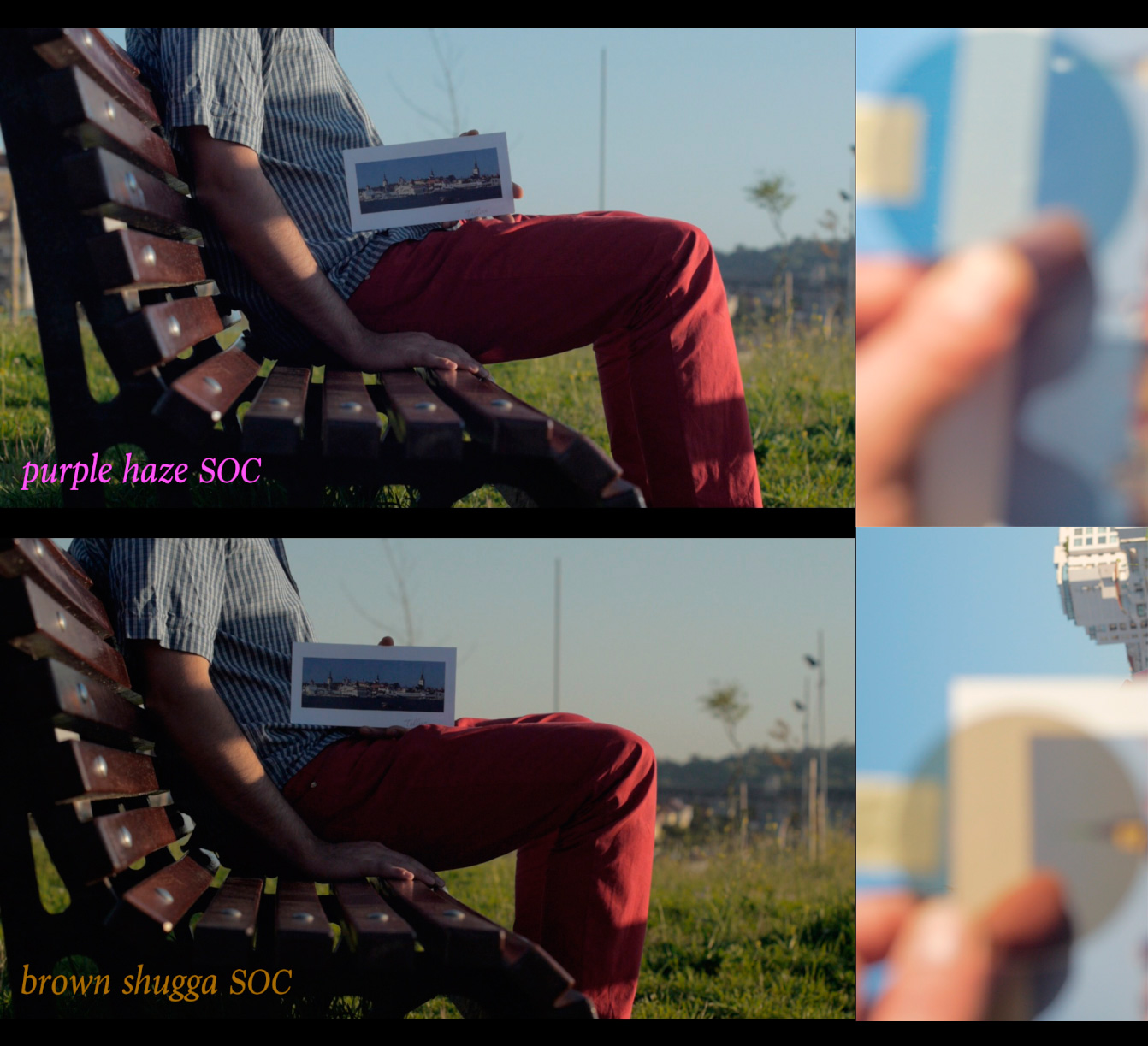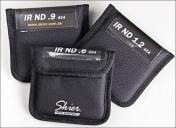
-
re. polarization effects, not all faders act as polarizers. That was actually a big deal for me as I shoot 3D with two cameras (GH2s), and as the filters always screw on differently on two bodies, each would get a different amount of reflections (a disaster in 3D).
Faders are really two polarizers, but there are two ways of doing it: using only linears, or a circular and a linear. If you find one with a circular at the front, it effectively unpolarizes the light before it fades, so the fader no longer acts as a polarizer at all.
Years ago I did eventually find faders like that, they just happened to be the cheapest on Ebay and not bad at all.
-
I ordered a Fotga 46mm Slim Wide Band Fader ND (W) to use with my original model 20mm f/1.7. I wouldn't normally use a variable ND filter, but I wanted a compact, lightweight "walking around" setup so my mattebox and 4x4" Schneider NDs were out of the question.
The filter arrived in three pieces - the front retaining ring and front glass had fallen out. The front glass had left a crescent-shaped scratch on the rear glass, but nothing that would affect the image. I put it back together, taking a few tries to get the retaining ring screwed down tight while not shifting the front glass from alignment so the min-max markings would be valid.
The design of the original 20mm gave me problems with 46-49mm step-up rings binding the lens as it focussed to infinity, because the filter thread of the lens is recessed very tight into an outer lip, but the bevelled edge of the Fotga filter meant that it fit without any problems. I did not need to use the 46mm UV filter which I removed the glass from to make a stand-off ring for clearance purposes.
There are 49mm filter threads on the front of the Fotga. The polarizing effect is strong, one of the reasons I wouldn't normally use a fader ND. I might buy a cheap 46mm polarizer filter and remove the glass from it, so that can first be mounted to the lens, then the fader ND - that way, I can dial the fader to the level of ND I need, and then rotate the whole assembly together to adjust the polarizing effect. I don't expect to see any vignetting on the 20mm, but it would need to be tested to know for sure.
I don't get any wide-angle lens "X" problems or uneven density in the frame, but the 20mm isn't very wide.
I don't see any softening of the image when I did some on/off comparison tests, but the 20mm isn't very telephoto.
Setting the filter to max leads to a noticeable loss of contrast, with light flaring into the shadows and midtones. But that's a crazy amount of ND for anything other than long time exposures, and using the filter at the second or third dot down from max is more than enough for general use, and doesn't show any loss of contrast. This assumes that your filter was/is aligned at the factory just as I aligned mine. It's very easy to see the max setting as it quickly "tips over" from that point, so that's what I went by.
There's a slight, and consistent, yellow/green colour shift. Easily corrected in post, I adjust my WB one point towards magenta and one point towards blue, which gets it pretty close to begin with.
As for infrared contamination, the GH2 is pretty good on its own compare to other cameras I've worked with, and with the filter I don't see any difference at all. That's good, but probably says more about the GH2 than the filter - other cameras that have infrared contamination issues may see them exacerbated by the filter.
Overall, YMMV with other focal lengths, but for the Panasonic 20mm, I'm quite pleased., and have no plans to buy a more expensive variable ND filter for this particular lens.
-
Very interesting video @VK thanks for posting
Now 1 thing is theory and another practice, ideally they can shake hands :P
So I did the test myself and it I can confirm that genustech eclipse clearly tints footage blueish or brownish depending on polarisers' angle. Now, in practice, Aron's method it's not practical at all. Why? It is not only that is time consuming if on a tripod, it is not that's a PITA when handheld it's because it kind of defeats the purpose of variND, at least for me... in some situations.Explaining; if I'm using native µFT lens or one which is not declicked or still I want to keep same DOF while changing sceneries and overall lighting in a run and gun chicken style, I'm going to control light with vND, so even if I set it to it's "purple mode" that's gonna change as soon I start rotating it.
Ok, problems have solutions and the joyful path to reach them (I should have been a priest, but one of those who can marry and fuck their way to heavens, sorry bitt OT). As starters I think helps this method to use a led torch with white paper between it and the polariser and point them to the lens, seems easier to spot the right tint in broad daylight. Secondly - and please this are still very early notes - I've noticed that no matter what light conditions, eclipse vND seems to more rapidly shift into brown tint at the beginning and end of it's range. Also the amount of rotation needed to shift the tint to purple is not that much, maybe 15, 20 º. So it shouldn't be very difficult to use this great idea of double rotatory system and establish correlative markings between amount of ND effect and tint. This is now theory but, ideally, one would be able to compensate live when shooting.
If there are more PVs using eclipse... or other vND with similar effect, we could think better together ,-)
Don't worry master @Vitaliy IF that happens we would open a shinny new thread :P
-
In my first clip with the GH4 one could see softness in some daylight shots. Most likely it was caused by a cheaply Vari-ND: vimeo.com/95081191. So I have bought a better one - the Heliopan (77mm). I´m entirely satisfied with this one so far. Take a look and build your own opinion. The first 70 seconds were all shot with the Heliopan - mainly on a street party around the corner. At the end you can watch a side by side comparison: the left side were always shot with the Heliopan.
Footage is untouched - just some stabilization in post. UHD / 29.976 downscaled to 1080p.
Iso: 200-800 Camera: Panasonic GH4 + old Kit 14-140
-
If you're going to get a variable ND, Marumi is definitely a high quality option easily on par with Tiffen's VariND. You just want to make sure that you are getting an authentic Marumi product-- there are a lot dubious Marumi-branded filters on eBay and Amazon. 2Filter is a good vendor though. They know their stuff.
-
Has anybody tried these ND¨s: Marumi DHG Variable ND2-ND400
http://www.2filter.com/marumi/marumi_variable_ND_DHG_filter.html
-
i would even say... great news!
-
These are very good news :-)
-
They are really good looking at all samples I got from them.
Plus, they will be among our Black Friday deals :-)

 bmpcc1.jpg489 x 711 - 43K
bmpcc1.jpg489 x 711 - 43K
 bmpcc2.jpg800 x 581 - 109K
bmpcc2.jpg800 x 581 - 109K -
What about Haida Pro II slim Fader Filter? Thanks
-
The Tiffin Variable ND beat the Genustech Eclipse in this test:
http://www.personal-view.com/talks/discussion/comment/147947#Comment_147947
-
Yep, seems really good.
-
Somebody has any experience with these: http://www.skier.com.tw/web/en/Products/products_ad.jsp?gs_id=CY1370489379957
They're on ebay for around 100€... doesn't sound bad for HotMirror NDs
-
Just watched the new Star Trek?
-
Guys I have always wondered about how far are we in terms of technology to getting a selective ND filter, meaning ,its smart (with a chip i assume) enough to recognize blowing out areas (Or highlights) and applying the ND filter to that part of the frame and knowing what parts are exposed correctly or under exposed and leaving them as is without applying the ND filter..I guess that would be the dream ND filter.
-
@vicharris Just recently got the 77mm Tiffen Indie Kit with 4 WW ND filters (.3,.6,.9, & 1.2).Happy with quality on initial tests. Will use on feature film I'm shooting in March-April.I haven't forgot your recommendation for shooting at 1/40 or 1/30. Will test soon. If you haven't seen trailer, here's link. You may dig it. http://personal-view.com/talks/discussion/5966/the-crazy-life-trailer-hacked-gh2-feature-film#Item_2
-
@feha Cool. I was just getting ready to order one but I'll wait till you have time to check it out. Thanks again.
-
@vicharris , i will check tomorrow, have one vintage zoom lens ... till now i just tested with Voigtländer 25mm 0.95 ...
-
@matt_gh2 I know your question is old but I couldn't really tell the difference between my WW Tiffen and my normal one. That's 4x4 ND glass though. They did both however blow away the LCW fader as stated above. Hope that helps. I'm going to use my LCW as a coaster for our nice driftwood table now. :)
-
@feha Have you checked for softness beyond 50mm and 85mm on MFT? LCW fader is garbage for that and the regular Genus isn't much better. I'm pretty sure it's good just want to hear it from someone here. Thanks
-
@azza_act , i do have Genus Eclipse 77mm (outer 82mm) it looks and works great. Have not made any extended tests yet, but it gives very good results, my first impression.
-
Has anyone had an experience with the Genus Eclipse yet? I need to upgrade from my 72mm heliopad (I have wider lenses now) there doesn't seem to be a lot of reviews.
Howdy, Stranger!
It looks like you're new here. If you want to get involved, click one of these buttons!
Categories
- Topics List23,993
- Blog5,725
- General and News1,354
- Hacks and Patches1,153
- ↳ Top Settings33
- ↳ Beginners256
- ↳ Archives402
- ↳ Hacks News and Development56
- Cameras2,368
- ↳ Panasonic995
- ↳ Canon118
- ↳ Sony156
- ↳ Nikon96
- ↳ Pentax and Samsung70
- ↳ Olympus and Fujifilm102
- ↳ Compacts and Camcorders300
- ↳ Smartphones for video97
- ↳ Pro Video Cameras191
- ↳ BlackMagic and other raw cameras116
- Skill1,960
- ↳ Business and distribution66
- ↳ Preparation, scripts and legal38
- ↳ Art149
- ↳ Import, Convert, Exporting291
- ↳ Editors191
- ↳ Effects and stunts115
- ↳ Color grading197
- ↳ Sound and Music280
- ↳ Lighting96
- ↳ Software and storage tips266
- Gear5,420
- ↳ Filters, Adapters, Matte boxes344
- ↳ Lenses1,582
- ↳ Follow focus and gears93
- ↳ Sound499
- ↳ Lighting gear314
- ↳ Camera movement230
- ↳ Gimbals and copters302
- ↳ Rigs and related stuff273
- ↳ Power solutions83
- ↳ Monitors and viewfinders340
- ↳ Tripods and fluid heads139
- ↳ Storage286
- ↳ Computers and studio gear560
- ↳ VR and 3D248
- Showcase1,859
- Marketplace2,834
- Offtopic1,320











